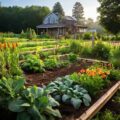Discovering the Grain Wisdom of Blue Zones
In our quest for health and longevity, we often look to those who have mastered the art of living well. The Blue Zones, regions where people live extraordinarily long and healthy lives, offer us a treasure trove of wisdom, particularly when it comes to their relationship with grains. These centenarian-rich areas have much to teach us about nourishing our bodies and souls with the humble yet powerful foods that have sustained humanity for millennia.
The Heart of Blue Zone Nutrition: Whole Grains
At the core of Blue Zone diets lies a profound appreciation for whole grains. Unlike the refined grains that dominate many modern diets, the grains consumed in Blue Zones are minimally processed, retaining their natural fiber, vitamins, and minerals. This wholesome approach to grain consumption contributes significantly to the overall health and longevity of Blue Zone inhabitants.
In Okinawa, Japan, for instance, the traditional diet includes a variety of whole grains such as brown rice and barley. These grains provide sustained energy and are rich in nutrients that support heart health and digestion. Similarly, in the Mediterranean Blue Zones, whole grain breads and pastas are staples, often made from ancient wheat varieties that are more nutrient-dense than modern wheat.
Variety: The Spice of Long Life
Blue Zone communities don’t just stick to one type of grain. They embrace variety, understanding that different grains offer unique nutritional profiles. In Sardinia, Italy, residents enjoy a range of grains including barley, wheat, and rye. This diversity ensures a broad spectrum of nutrients and keeps meals interesting and satisfying.
Incorporating a variety of grains into our diets can be a joyful exploration. From the nutty flavor of quinoa to the hearty texture of farro, each grain brings its own character to the table. This diversity not only nourishes our bodies but also delights our palates, making healthy eating a pleasure rather than a chore.
The Art of Preparation: Slow Food and Fermentation
Blue Zone communities often practice traditional methods of grain preparation that enhance both flavor and nutrition. Sourdough bread, a staple in many Blue Zones, is made through a slow fermentation process that not only creates a delicious taste but also makes the nutrients in the grains more bioavailable.
In Nicoya, Costa Rica, corn is often prepared through nixtamalization, an ancient technique that involves soaking corn in lime water. This process increases the nutritional value of the corn, making essential nutrients like niacin more accessible to the body. These time-honored preparation methods remind us that sometimes, the old ways are indeed the best ways.
Beyond Nutrition: The Social Aspect of Grains
In Blue Zones, grains are more than just food; they’re a cornerstone of social and cultural life. Sharing a loaf of bread or a bowl of grain-based soup is a way of connecting with family and community. This social aspect of eating contributes significantly to the overall well-being and longevity of Blue Zone inhabitants.
We can learn from this by making our grain-based meals occasions for connection. Whether it’s baking bread with loved ones or hosting a potluck featuring various grain dishes, these activities nourish our bodies and our relationships, both crucial for a long and happy life.
Embracing Blue Zone Grain Wisdom in Modern Life
Incorporating the grain wisdom of Blue Zones into our lives doesn’t require a complete lifestyle overhaul. Small, consistent changes can make a significant difference. Here are some simple ways to embrace Blue Zone grain secrets:
- Choose whole grain options over refined grains whenever possible
- Experiment with a variety of grains in your cooking
- Try traditional preparation methods like sourdough fermentation
- Make grain-based meals a time for social connection
- Appreciate the cultural and historical significance of grains in your diet
By adopting these practices, we not only improve our nutrition but also connect with the timeless wisdom that has sustained Blue Zone communities for generations.
Frequently Asked Questions About Blue Zone Grain Secrets
1. What are the most common grains consumed in Blue Zones?
The most common grains in Blue Zones include whole wheat, barley, oats, corn, and rice. However, the specific grains vary depending on the region. For example, Sardinians consume a lot of barley, while Okinawans eat more rice.
2. How do Blue Zone inhabitants prepare their grains?
Blue Zone inhabitants often use traditional preparation methods such as fermentation (for sourdough bread), nixtamalization (for corn), and slow cooking. These methods not only enhance flavor but also increase the bioavailability of nutrients.
3. Can I get the same benefits from modern whole grain products?
While modern whole grain products are beneficial, they may not offer the same level of benefits as traditionally prepared grains. However, choosing whole grains over refined grains is still a step in the right direction for better health.
4. How much of the Blue Zone diet consists of grains?
Grains typically make up a significant portion of the Blue Zone diet, often accounting for 50-60% of daily caloric intake. However, it’s important to note that these are whole grains, not refined grains.
5. Are there any grains that are particularly emphasized in Blue Zones?
While the specific grains vary by region, some standout grains in Blue Zones include barley in Sardinia, corn in Nicoya, and rice in Okinawa. What’s consistent across Blue Zones is the emphasis on whole, minimally processed grains.
By embracing the grain wisdom of Blue Zones, we open ourselves to a world of nutritional benefits, culinary delights, and social connections. These humble foods, prepared with care and enjoyed in good company, may just hold the secret to a longer, healthier, and more joyful life.









